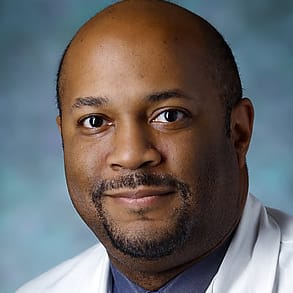Christopher Golden, medical director of the newborn nursery, discusses his research regarding cerebral oxygenation in newborns. This collaborative research effort with the Department of Radiology at Johns Hopkins aims to develop understanding of brain function, and how children with abnormalities in this function can be assessed and how long term outcomes can be improved.
Hi, I'm Doctor Christopher Golden. I'm a neonatologist at the Johns Hopkins Hospital and Faculty in the School of Medicine in the Division of Neonatology. I am Medical Director of the newborn Nursery at Johns Hopkins. In addition to caring for healthy newborns and providing routine care for babies who deliver at Hopkins. We engage in research to understand how brain function occurs and how Children who have abnormalities in said function can be assessed and monitored to improve long term outcomes. Cerebral oxygenation is an important parameter to assess the degree of tissue utilization of oxygen. However, measurement of cerebral oxygenation in babies has been difficult to do in collaboration with research colleagues in the Department of Radiology at Johns Hopkins. We have been able to develop a technique called trust T two relaxation underpin tagging which allows us to assess cerebral oxygenation in babies. This technique has been used and studied in our population of newborns at Johns Hopkins Hospital. And the information has provided valuable insights into the way that babies handle oxygen within their brain. Such information can be useful going forward in Children who suffer brain injury at or around the time of delivery. An additional feature is that we have developed techniques to remove abnormal tissue signal from MRI testing. As you can recognize babies move a lot during procedures and obtaining adequate measurement of cerebral blood flow. And cerebral oxygenation may be difficult. We've recently published a paper demonstrating the ability to clear out abnormal signals that allow for very, very clear resolution of blood flow within the brain and assessment of cerebral oxygenation. We continue to do work with our newborns and study other parameters within the brain to allow us to determine what a healthy brain looks like and what an unhealthy brain looks like, which will allow us to provide better outcomes for our newborns. I want to thank my colleagues in neonatology who study brain injury at the clinical and the basic science level. And I'd also like to thank members of the Department of Radiology in particular, Dr Han Zhang Li, who supports us in providing the tools to do this research and to support the care of neonates.



